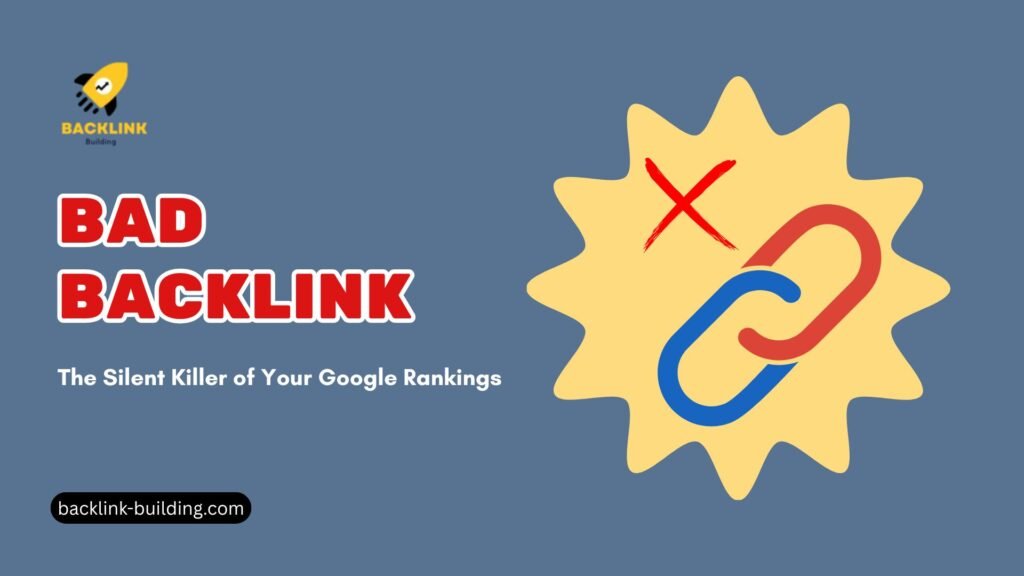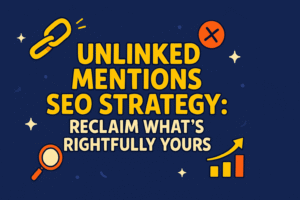
If you are working hard on your website and still not ranking well on Google, chances are you might be ignoring something super important. That something is bad backlinks.
Yes, you read that right. Bad backlinks can hurt your website more than you think. You may not even realize it, but these links can quietly damage your SEO efforts and push your site down in search results.
Let us talk about what bad backlinks are, why they are harmful, and how you can fix them to improve your Google rankings.
What Are Bad Backlinks?
Bad backlinks are links from other websites that hurt your site’s rankings on Google instead of helping. These links come from untrustworthy, irrelevant, or spammy sources. Google sees them as red flags, and if you have too many, your site could get penalized or lose visibility in search results.
What Makes a Backlink Bad?
Not all links are created equal. Here are some signs that a backlink might be bad:
1. Links from spammy websites
- If a site is full of ads, poor content, or shady stuff (like gambling, adult content, or scams), a link from it can damage your SEO.
2. Links from irrelevant sites
- Example: If you run a pet blog and get links from a plumbing site, Google might think you’re trying to manipulate rankings.
3. Paid links or link schemes
- If you pay someone to add your link without marking it as “sponsored” or “nofollow,” that’s against Google’s rules.
4. Too many links with exact-match anchor text
- If every link uses the same keyword as anchor text (like “buy running shoes online”), it looks unnatural to search engines.
5. Links from private blog networks (PBNs)
- PBNs are fake sites created just to link out. Google is very good at spotting them and penalizing the linked sites.
6. Links from hacked or penalized sites
- If your backlink is coming from a hacked site or one that Google already penalized, it can transfer negative trust signals to you.
These kinds of backlinks do more harm than good.
Why Are Bad Backlinks So Dangerous?
Bad backlinks are like poison for your website. Google wants to show the best and most trusted sites to its users. If your site has links from sketchy places, Google starts to question your website’s quality. Here’s a simple breakdown of why they are risky:
1. Google May Penalize Your Website
Google wants to show trustworthy sites. If your site has too many bad backlinks (links from spammy or shady websites), Google may think your content is not good or that you’re trying to cheat the system. This can lead to:
- Lower search rankings
- Manual actions or penalties
- Loss of traffic
2. They Come From Low-Quality or Spammy Sites
Bad backlinks often come from:
- Link farms (sites created only for link building)
- Irrelevant websites
- Sites with adult, gambling, or malware content
These links don’t add any real value and can make your site look suspicious.
3. They Don’t Match Your Niche
Imagine a gardening blog getting backlinks from a casino site—it just doesn’t make sense. Google looks at relevance, so unrelated backlinks confuse search engines and can drag your site down.
4. Anchor Text Manipulation
If a lot of your backlinks use exact-match keywords in the anchor text (like “best cheap shoes” over and over), it looks unnatural. This is a red flag for Google and may get your site penalized for over-optimization.
5. Too Many, Too Fast
A sudden spike in backlinks, especially from low-quality sites, can look like you’re trying to game the algorithm. This unnatural growth pattern makes your backlink profile look suspicious.
6. Hurts Your Website’s Credibility
Visitors may click on those shady links and end up on sketchy sites. This lowers trust in your brand and could increase your bounce rate, which Google watches closely.
7. They Can Spread Malware
Some bad backlinks come from hacked or dangerous sites. If users click and get viruses or see inappropriate content, it damages your brand and might get your site flagged by security tools.
It is like inviting trouble without knowing it.
Real-Life Example
Imagine you run a blog about healthy recipes. One day, you notice a backlink to your site from a site that talks about adult content. That is a red flag.
Even if you did not ask for that link, it still affects you.
Google sees the link and thinks, Hmm, this is strange. Maybe this site is not trustworthy.
And boom—your rankings take a hit.
How Do Bad Backlinks Happen?
You might wonder, where do these links even come from? Here are a few common ways:
- You bought backlinks from a low-quality service
- You used automated tools that create spammy links
- Someone else linked to you from a spammy site
- You participated in link exchanges or shady directories
- You commented on blogs just to drop your link
Sometimes it is not even your fault. But it still causes harm.
How To Find Bad Backlinks
So, how do you even know if you have bad backlinks? Here is how you can check:
Use a Backlink Checker Tool
There are tools like:
- Google Search Console (it is free)
- Ahrefs
- Semrush
- Moz
These tools let you see who is linking to your site.
Look For Red Flags
Once you get the list, check for:
- Sites with strange or unrelated topics
- Websites that look like they were made in a hurry
- Pages with too many ads or popups
- Links from foreign language sites (if your site is in English)
- Anchor text that makes no sense
What To Do If You Find Bad Backlinks
You found some bad backlinks. Now what? Here is what you can do:
1. Reach Out and Ask for Removal
Reach out to the website owner or webmaster and politely request that the backlink be removed.
Here’s a short template you can use:
Hi [Name],
I noticed that your website is linking to mine on [URL]. I’d appreciate it if you could remove this link, as it may not be the best fit for our audience.
Thank you for your time and help!
Best regards,
[Your Name]
You may not always get a reply, and that’s okay. Just do your best.
2. Disavow the Links
If the owner does not respond or refuses, your next step is to use the Google Disavow Tool. This tells Google not to count those links when evaluating your site.
Here’s how:
- Create a .txt file listing all the domains or specific URLs you want to disavow
- Go to the Google Disavow Tool
- Upload the file
⚠️ Only use this tool if you’re sure the links are harmful. Misuse can hurt your SEO.
Tips To Avoid Bad Backlinks in the Future
Here are a few ways to keep your backlink profile clean and healthy:
- Do not buy backlinks from random sellers
- Avoid link exchanges or shady offers
- Focus on creating helpful, shareable content
- Build relationships with trusted websites in your niche
- Monitor your backlinks regularly
- Say no to automated link-building tools
How Google Handles Bad Backlinks
Google is smart. It knows that sometimes websites get bad links they did not ask for. So it tries to ignore those links on its own.
But if there are too many bad backlinks, Google might take action.
Here is how:
- Algorithmic penalties (Google Penalties): Your rankings drop slowly without a clear reason.
- Manual actions: You get a notice in Search Console saying your site is affected.
Either way, the result is bad news for your SEO.
Can Bad Backlinks Be Fixed?
Yes, they can. But it takes time and effort.
You need to:
- Find the bad links
- Remove or disavow them
- Build new, high-quality backlinks
- Monitor your site regularly
It is not a one-time thing. SEO is like a garden. You need to keep pulling out the weeds.
How Often Should You Check Your Backlinks?
At least once every few months. If you are actively doing SEO, you should check monthly.
It is like a health check for your website.
Bonus Tip: Stay Away From Link Farms
Link farms are sites made only to link to other websites. They look like normal sites but have no real value.
If your backlink is on a link farm, that is a red flag.
Here is how to spot one:
- The site has lots of random topics
- It links to hundreds of other websites
- The content looks like it was written by a robot
- You see words like “sponsored post” too often
If you see your link on such a site, get rid of it.
Final Thoughts
Bad backlinks are like termites in a house. You might not see the damage right away, but they are slowly breaking things down.
If you care about your Google rankings (and you should), you need to keep your backlink profile clean and healthy.
Here is what you should remember:
- Check your backlinks regularly
- Remove or disavow the bad ones
- Build good backlinks through honest work
- Do not take shortcuts that promise fast results
Google likes websites that play fair. So stay honest, stay consistent, and keep an eye on your links.
Quick Recap
To wrap it up, here is a simple checklist:
- Use tools to find your backlinks
- Spot the bad ones (spammy, irrelevant, low-quality)
- Reach out for removal or use the Disavow Tool
- Avoid buying or trading links
- Create helpful content people want to link to
- Keep checking your backlink health
Doing this will protect your rankings and keep your site strong in the eyes of Google.


